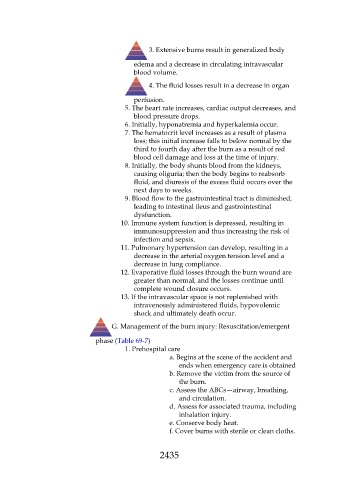Page 2435 - Saunders Comprehensive Review For NCLEX-RN
P. 2435
3. Extensive burns result in generalized body
edema and a decrease in circulating intravascular
blood volume.
4. The fluid losses result in a decrease in organ
perfusion.
5. The heart rate increases, cardiac output decreases, and
blood pressure drops.
6. Initially, hyponatremia and hyperkalemia occur.
7. The hematocrit level increases as a result of plasma
loss; this initial increase falls to below normal by the
third to fourth day after the burn as a result of red
blood cell damage and loss at the time of injury.
8. Initially, the body shunts blood from the kidneys,
causing oliguria; then the body begins to reabsorb
fluid, and diuresis of the excess fluid occurs over the
next days to weeks.
9. Blood flow to the gastrointestinal tract is diminished,
leading to intestinal ileus and gastrointestinal
dysfunction.
10. Immune system function is depressed, resulting in
immunosuppression and thus increasing the risk of
infection and sepsis.
11. Pulmonary hypertension can develop, resulting in a
decrease in the arterial oxygen tension level and a
decrease in lung compliance.
12. Evaporative fluid losses through the burn wound are
greater than normal, and the losses continue until
complete wound closure occurs.
13. If the intravascular space is not replenished with
intravenously administered fluids, hypovolemic
shock and ultimately death occur.
G. Management of the burn injury: Resuscitation/emergent
phase (Table 69-7)
1. Prehospital care
a. Begins at the scene of the accident and
ends when emergency care is obtained
b. Remove the victim from the source of
the burn.
c. Assess the ABCs—airway, breathing,
and circulation.
d. Assess for associated trauma, including
inhalation injury.
e. Conserve body heat.
f. Cover burns with sterile or clean cloths.
2435

